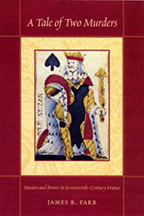
September 9, 2005
Historian investigates double homicide in 17th century France

|
WEST LAFAYETTE, Ind. – A Purdue University history professor's latest book re-examines the case of a famous murder-mystery in 17th century France.
"People in France are still talking about the Giroux affair, but no one knows what really happened," says James R. Farr, professor of European history. "Even though the story reads like fiction, this actually happened."
"A Tale of Two Murders: Passion and Power in Seventeenth-Century France," (Duke University Press, $21.95) will be released in October.
"To start with, for several years no bodies were found – just two missing men, making it difficult to know if murder actually was committed," Farr says. "There were more than 30 alleged accomplices in this suspected dual murder, and those involved included some of the most distinguished ladies and gentlemen in Burgundy, as well as their servants, and a doctor accused of poisoning patients. Even a prince was tied to the accused.

|
"Not only is this an exciting, scandalous tale, but it's a great lesson in how law and morality were defined 400 years ago during a time that most people associate with the king's legendary guard, the Three Musketeers."
On Sept. 6, 1638, nobleman Pierre Baillet and his manservant Philibert Neugot were last seen on their way to the home of Baillet's cousin, Philippe Giroux, a royal court judge. It was reported that the two men were meeting to reconcile about the affair Giroux was having with Baillet's wife, Marie Fyot. Baillet and Neugot were never seen again after they entered the Giroux home, and their bones were discovered five years later. Farr's account of events follows the twists and turns of the investigation – and criminal trial that spanned 1639-43 – from start to finish.
"Adultery was taken seriously, and sometimes even punishable by death, but it happened all of the time," Farr says.
Farr began investigating this story when he found the trial transcript 10 years ago in Dijon, France, while working on another book, "Authority and Sexuality in Early Modern Burgundy, 1550-1730." He made several trips to France and visited the Giroux family estate, and he also met with the current owner of the home where the alleged murders took place.
The Giroux trial transcripts included nearly 300 depositions of witnesses and interrogations of the accused – some of whom were tortured.
"All of the evidence is tainted because power and influence was exerted in every aspect of the investigation," Farr says. "But this is where detective work as a historian helps. Investigating this case was possible by understanding the 17th century economic conditions, land holdings and political strife in this famous wine-producing region."
In addition to translating the transcripts, Farr also pieced together information and social networks from baptismal and marriage records. Power networks often were based on family relations and man-made relations, called spiritual kinships, in which many important allegiances of power were constructed when someone stood as godparent for another, Farr says. Also, when a man and woman married, their status was elevated by the number of powerful families that signed the marriage contract.
Farr's research for this book was funded by the John Simon Guggenheim Foundation and the American Council of Learned Societies.
Writer: Amy Patterson Neubert, (765) 494-9723, apatterson@purdue.edu
Source: James Farr, (765) 496-2698, jrfarr@purdue.edu
Purdue News Service: (765) 494-2096; purduenews@purdue.edu
Note to Journalists: Journalists interested in review copies of "A Tale of Two Murders" can contact Laura Sell, publicist with Duke University Press, at (919) 687-3639, lsell@dukepress.edu.
Related Web site:
Purdue Department of History
To the News Service home page